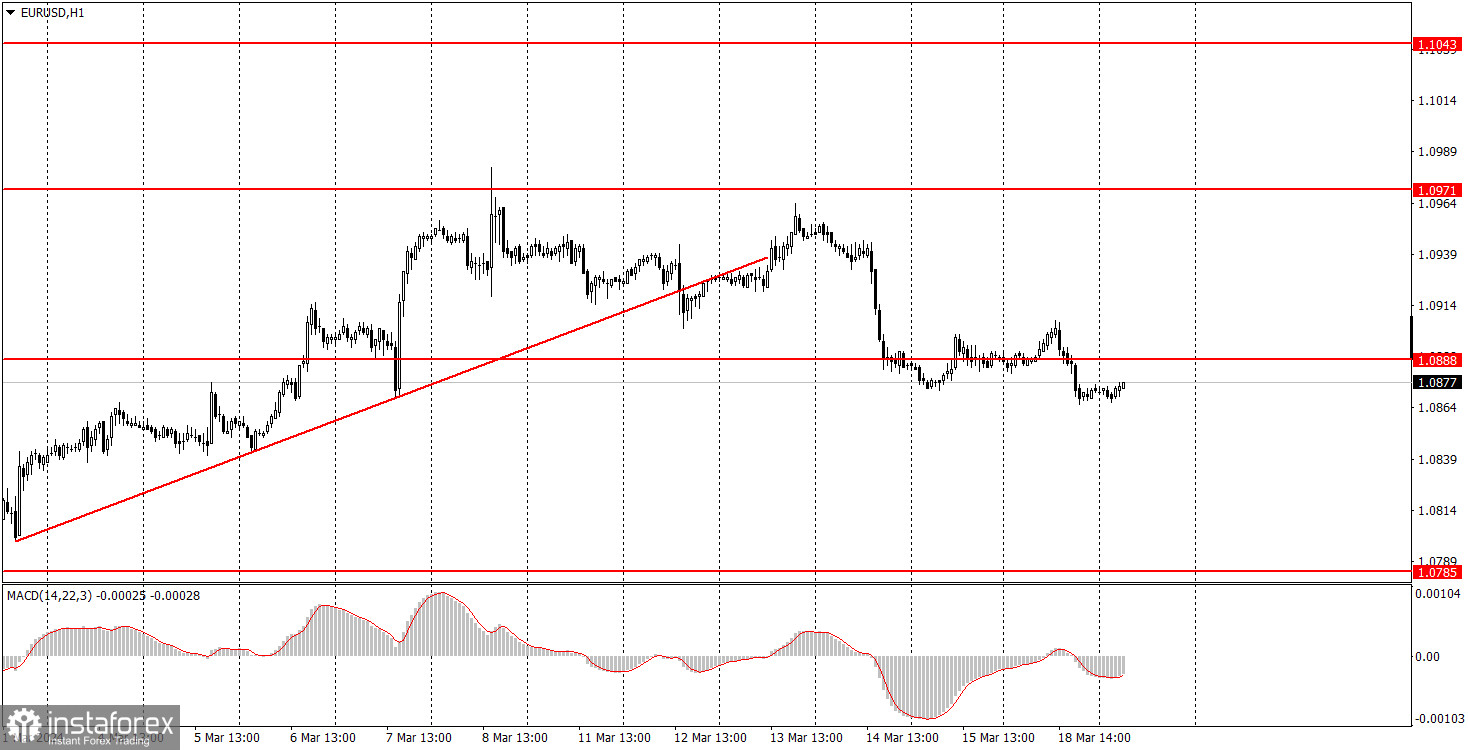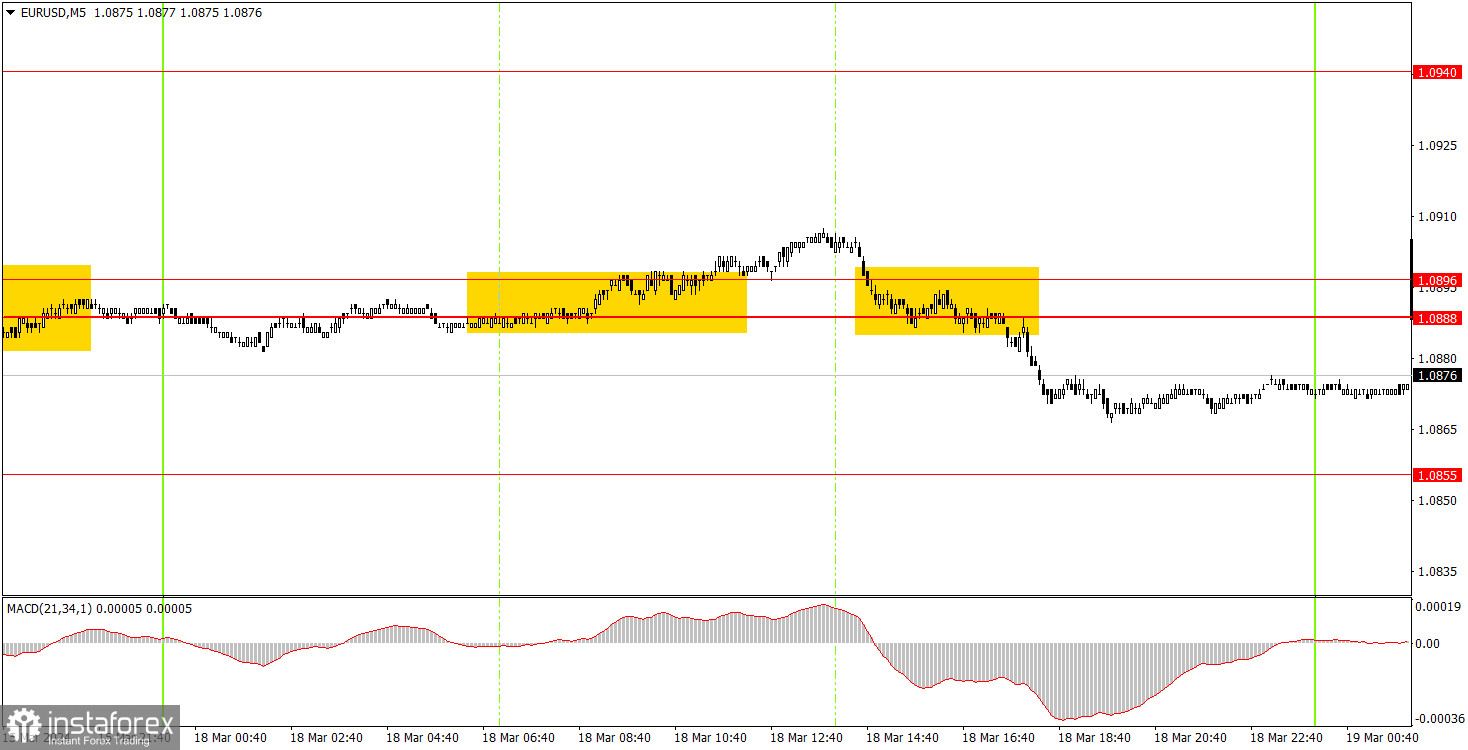Analyzing Monday's trades:
EUR/USD on 1H chart

EUR/USD showed ultra-low volatility again on Monday. The range from the day's low to the high was only 40 pips. Therefore, we did not expect any reliable trading signals or opportunities to make profits from any of the trades. We already warned you that it will likely be another "boring Monday," and that the Eurozone inflation report would not evoke any emotions from the market. As anticipated, the second estimate of European inflation did not differ from the first, as it remained at 2.6% annually.
Therefore, the euro gradually falls ahead of the Federal Reserve meeting. We believe that the only logical step is for the pair to move downwards. The single currency remains unreasonably expensive, as expectations regarding the Fed rate continue to get stronger, while expectations regarding the European Central Bank rate are getting weaker. It is now clear that at best, both central banks will start policy easing in June. At worst, the Fed will start rate cuts much later. Do recall that earlier in the year, the expectations were the opposite, which contributed to the euro's growth.
EUR/USD on 5M chart

Two trading signals were generated on the 5-minute timeframe. First, the pair broke through the range of 1.0888-1.0896 upwards, and then downwards. In the first case, it couldn't even move 10 pips in the intended direction. In the second case, although it was a stronger move, novice traders could only earn 10 pips from this trade. Once again, take note that if volatility is low, we have a low chance of making a profit from any trading signals.
Trading tips on Tuesday:
On the hourly chart, EUR/USD has started to move downwards, and we can only hope that this time the dollar will rise. We still expect a pronounced decline from the euro, which, in our opinion, should continue for quite some time. We assume that the bullish correction, which lasted for over a month, has finally ended. If that's the case, then a new downward trend will form. Remember that the euro still lacks significant factors that can support its growth.
The key levels on the 5M chart are 1.0568, 1.0611-1.0618, 1.0668, 1.0725, 1.0785-1.0797, 1.0855, 1.0888-1.0896, 1.0940, 1.0971-1.0981, 1.1011, 1.1043, 1.1091. On Tuesday, the euro area economic calendar is quiet, while the US will publish secondary reports on the real estate market. We don't expect significant reactions to them. However, the results of the FOMC meeting will be announced tomorrow, so volatility may increase gradually.
Basic trading rules:
1) Signal strength is determined by the time taken for its formation (either a bounce or level breach). A shorter formation time indicates a stronger signal.
2) If two or more trades around a certain level are initiated based on false signals, subsequent signals from that level should be disregarded.
3) In a flat market, any currency pair can produce multiple false signals or none at all. In any case, the flat trend is not the best condition for trading.
4) Trading activities are confined between the onset of the European session and mid-way through the U.S. session, after which all open trades should be manually closed.
5) On the 30-minute timeframe, trades based on MACD signals are only advisable amidst substantial volatility and an established trend, confirmed either by a trendline or trend channel.
6) If two levels lie closely together (ranging from 5 to 15 pips apart), they should be considered as a support or resistance zone.
How to read charts:
Support and Resistance price levels can serve as targets when buying or selling. You can place Take Profit levels near them.
Red lines represent channels or trend lines, depicting the current market trend and indicating the preferable trading direction.
The MACD(14,22,3) indicator, encompassing both the histogram and signal line, acts as an auxiliary tool and can also be used as a signal source.
Significant speeches and reports (always noted in the news calendar) can profoundly influence the price dynamics. Hence, trading during their release calls for heightened caution. It may be reasonable to exit the market to prevent abrupt price reversals against the prevailing trend.
Beginning traders should always remember that not every trade will yield profit. Establishing a clear strategy coupled with sound money management is the cornerstone of sustained trading success.
 English
English 
 Русский
Русский Bahasa Indonesia
Bahasa Indonesia Bahasa Malay
Bahasa Malay ไทย
ไทย Español
Español Deutsch
Deutsch Български
Български Français
Français Tiếng Việt
Tiếng Việt 中文
中文 বাংলা
বাংলা हिन्दी
हिन्दी Čeština
Čeština Українська
Українська Română
Română

